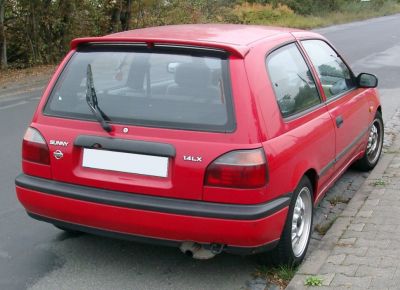 1988 Volkswagen Golf II (5-door, facelift 1987) Dimensions, Size & Specs
1988 Volkswagen Golf II (5-door, facelift 1987) Dimensions, Size & SpecsMeasurements of the 1988 Volkswagen Golf II, engineered for optimal performance and comfort
| Dimensions | |
|---|---|
| Length: | 3985-4040 mm156.9-159.1 in13.1-13.3 ft |
| Width: | 1665-1700 mm65.6-66.9 in5.5-5.6 ft |
| Height: | 1405-1415 mm55.3-55.7 in4.6-4.6 ft |
| Trunk Capacity: | 230-345 liter8.1-12.2 cu ft |
| Trunk Capacity (Max): | 1030-1145 liter36.4-40.4 cu ft |
| Weight Specifications | |
| Curb Weight: | 910-1105 kg2006-2436 lbs |
| Maximal permitted Weight: | 1370-1570 kg3020-3461 lbs |
| Tire Specifications | |
| Rims Sizes: | 13-inch rims:
|
| Tire Sizes: |
|
The Volkswagen Golf II 5-door facelift model, produced between 1987 and 1991 with the 1988 model year as a highlight, is a classic compact hatchback valued for its practical design and versatile size. It measures between 3985 mm and 4040 mm (157 to 159 inches) in length, making it a comfortable fit for urban driving and parking. The width ranges from 1665 mm to 1700 mm (65.5 to 67 inches), providing sufficient interior space while maintaining a manageable external profile. Standing 1405 mm to 1415 mm tall (55.3 to 55.7 inches), it offers a balanced stance that contributes to its stable driving dynamics.
Weight-wise, the curb weight of the Golf II 5-door facelift varies from 910 kg to 1105 kg (2006 to 2437 lbs), depending on equipment and trim level. The maximum weight capacity ranges between 1370 kg and 1570 kg (3020 to 3462 lbs), ensuring it can comfortably carry passengers and cargo. Luggage capacity is notably practical for the segment, with standard trunk volume ranging from 230 to 345 liters (8.1 to 12.2 cubic feet). Folding the rear seats expands this capacity substantially to between 1030 and 1145 liters (36.4 to 40.4 cubic feet), offering excellent cargo versatility.
The Golf II facelift supports various rim sizes, including 5J x 13, 6J x 14, 6.5J x 15, and 5.5J x 13, paired with corresponding tire dimensions such as 155/65 R13, 185/60 R14, 195/50 R15, and 175/70 R13. This range of wheel and tire options provides a good balance between comfort, handling, and road performance.
Overall, the Volkswagen Golf II 5-door facelift stands as a practical and efficient hatchback from the late 1980s and early 1990s, blending manageable exterior dimensions with a flexible interior layout — making it an enduring favorite among compact car enthusiasts and those seeking a dependable daily driver.
Discover the standout features that make the 1988 Volkswagen Golf II a leader in its class
Have a question? Please check our knowledgebase first.
The Volkswagen Golf II (5-door, facelift 1987) has a length ranging from 3985 mm to 4040 mm (approximately 157 inches to 159 inches). Its width varies between 1665 mm and 1700 mm (about 65.6 inches to 67 inches), while the height measures between 1405 mm and 1415 mm (around 55.3 inches to 55.7 inches). These dimensions place the Golf II firmly in the compact hatchback category, making it practical for urban driving and parking while still offering a comfortable interior space.
The curb weight of the Volkswagen Golf II (5-door, facelift 1987) ranges from 910 kg to 1105 kg (about 2006 to 2437 lbs), depending on the specific trim and options. Its maximum allowable weight ranges from 1370 kg to 1570 kg (approximately 3020 to 3462 lbs). A lighter curb weight contributes to nimble handling characteristics and better fuel economy compared to larger vehicles. The relatively low mass also helps the Golf II to be responsive on the road, promoting an engaging driving experience while keeping operational costs manageable.
The Volkswagen Golf II provides a practical luggage capacity given its compact size. With all seats in the upright position, it offers between 230 and 345 liters (8.1 to 12.2 cubic feet) of storage space, which is suitable for everyday groceries or small luggage pieces. When the rear seats are folded down, the available luggage capacity expands significantly to between 1030 and 1145 liters (36.4 to 40.4 cubic feet), allowing for the transport of larger items such as bicycles or bulkier cargo, enhancing the versatility of the hatchback layout.
The Volkswagen Golf II (5-door, facelift 1987) was equipped with an array of rim sizes including 5J x 13, 6J x 14, 6.5J x 14, and 5.5J x 15, coupled with tire sizes such as 155/65 R13, 185/60 R14, 195/50 R15, and 175/70 R13. Smaller rims with higher profile tires like 155/65 R13 typically improve ride comfort by providing more sidewall cushioning, which is ideal for everyday driving on rough city roads. Meanwhile, larger rims and lower profile tires (e.g., 195/50 R15) enhance cornering stability and sportier handling but might slightly reduce comfort on uneven surfaces.
Yes, the Volkswagen Golf II (5-door, facelift 1987) fits comfortably within a standard home garage. With its length ranging from 3985 mm to 4040 mm (157 to 159 inches) and width between 1665 mm and 1700 mm (65.6 to 67 inches), it is smaller than typical garage interior dimensions which often measure at least 6 meters (19.7 feet) in depth and 2.4 to 3 meters (7.9 to 9.8 feet) in width. This compact profile not only facilitates parking but also allows room to move around the vehicle inside the garage.
Compared to its predecessor, the Volkswagen Golf I, the Golf II (5-door, facelift 1987) features slightly increased exterior dimensions and improved interior space. The length of the Golf I was around 3700 mm (145.7 inches), whereas the Golf II ranges from 3985 mm to 4040 mm (157 to 159 inches), making it noticeably longer. The width and height were also increased from approximately 1600 mm (63 inches) and 1400 mm (55 inches) in the Golf I to 1665-1700 mm (65.6-67 inches) width and 1405-1415 mm (55.3-55.7 inches) height respectively in the Golf II. These incremental changes translated into enhanced passenger comfort and more cargo room, while maintaining a compact hatchback profile suitable for everyday use.
Dimensionally, the Volkswagen Golf II (5-door, facelift 1987) is on par with other popular compact hatchbacks from the late 1980s, such as the Ford Escort and Opel Kadett, which typically featured lengths around 4 meters (157 inches) and widths near 1.7 meters (67 inches). The Golf II’s dimensions reflect industry standards for practicality and urban maneuverability of the time while offering competitive interior space and cargo capacity. Its relatively modest height between 1405 and 1415 mm (55.3 to 55.7 inches) helped maintain a low center of gravity for good handling, a trait appreciated in sporty yet practical hatchbacks.
The Volkswagen Golf II facelift offered multiple rim and tire size combinations to suit different driving preferences and conditions. Rim sizes ranged from a smaller 5J x 13 to larger options such as 6J x 14, 6.5J x 14, 5.5J x 15, and 13 inches in diameter. Corresponding tire sizes included 155/65 R13, 185/60 R14, 195/50 R15, and 175/70 R13. Smaller rims with higher-profile tires generally provide a smoother ride and better absorption of road irregularities, ideal for city commuting, whereas larger rims with low-profile tires improve road grip and cornering ability, providing a sportier driving feel at the expense of slightly reduced comfort.
The Volkswagen Golf II (5-door, facelift 1987) was known for its solid build quality, practical hatchback design, and improved packaging that accommodated more passengers and cargo efficiently. It carried forward the reputation of the Golf series for offering excellent handling, reliable engine options, and user-friendly controls. The facelift in 1987 introduced updated styling with more modern bumpers and lighting elements, making the car visually appealing. Its reasonable fuel consumption, multiple trim options, and maintenance accessibility helped make it popular among commuters, small families, and driving enthusiasts throughout its production until 1991.
The curb weight of the Volkswagen Golf II (5-door, facelift 1987) varies between 910 kg and 1105 kg (approximately 2006 to 2437 lbs), depending on trim level, engine size, and equipment. Lighter variants tend to be more nimble and fuel-efficient, enhancing acceleration and braking performance, whereas heavier models might incorporate additional safety features or luxury options that add weight but improve ride comfort and stability. Weight also influences tire wear and suspension tuning; thus, manufacturers balanced weight carefully to optimize handling while maintaining durability and comfort in this versatile hatchback.
Discover similar sized cars.

| Production: | 1990-1995 |
|---|---|
| Model Year: | 1991 |
| Length: | 3975 mm156.5 in |
| Width: | 1690 mm66.5 in |
| Height: | 1395 mm54.9 in |

| Production: | 2023-present |
|---|---|
| Model Year: | 2023 |
| Length: | 4061 mm159.9 in |
| Width: | 1960 mm77.2 in |
| Height: | 1435 mm56.5 in |

| Production: | 2019-2023 |
|---|---|
| Model Year: | 2020 |
| Length: | 4060 mm159.8 in |
| Width: | 1960 mm77.2 in |
| Height: | 1435 mm56.5 in |

| Production: | 2020-present |
|---|---|
| Model Year: | 2021 |
| Length: | 4064-4070 mm160.0-160.2 in |
| Width: | 1993 mm78.5 in |
| Height: | 1450 mm57.1 in |

| Production: | 2017-2020 |
|---|---|
| Model Year: | 2017 |
| Length: | 4065 mm160.0 in |
| Width: | 1990 mm78.3 in |
| Height: | 1450 mm57.1 in |

| Production: | 1990-1994 |
|---|---|
| Model Year: | 1990 |
| Length: | 3915-3930 mm154.1-154.7 in |
| Width: | 1645-1660 mm64.8-65.4 in |
| Height: | 1370 mm53.9 in |

| Production: | 1990-1993 |
|---|---|
| Model Year: | 1990 |
| Length: | 3930 mm154.7 in |
| Width: | 1645 mm64.8 in |
| Height: | 1365 mm53.7 in |

| Production: | 2009-2012 |
|---|---|
| Model Year: | 2009 |
| Length: | 4045 mm159.3 in |
| Width: | 1972 mm77.6 in |
| Height: | 1472 mm58.0 in |
